
With its logically laid out approach, consistent and short lessons and enriched word lists, Sequential Spelling can help students learn to spell quickly, accurately without a lot of frustrating rote memorization.
What We Like
But watch out for…
What is Sequential Spelling
Developed by longtime educator and author Don McCabe, Sequential Spelling is an Orton-Gillingham-inspired spelling program designed for teachers and homeschool parents alike.
Using a combination of auditory dictation and personal correction and review, Sequential Spelling provides a thorough spelling curriculum based on word families and logical sequences and relationships.
What Ages or Grades is Sequential Spelling Appropriate For?
Sequential Spelling is designed for kids from the ages of about 6-13, or roughly grades 1-7.
The program is divided into seven progressively challenging levels, each of which roughly corresponds to:
| Level 1 | Ages 6-7 |
| Level 2 | Ages 7-8 |
| Level 3 | Ages 8-9 |
| Level 4 | Ages 9-10 |
| Level 5 | Ages 10-11 |
| Level 6 | Ages 11-12 |
| Level 7 | Ages 12-13 |
It is important to note that these ages are only a rough guideline for the program, and the levels are more of a reflection of complexity and challenge than anything else.
The program is really centered around actual spelling skill and, consequently, it can be used by precocious learners and those who are a little behind in the spelling quite easily and, due to the fact that neither grade nor age level is printed on the cover, without feeling embarrassed or condescended to.
This is especially true since Sequential Spelling can be a fairly rigorous spelling program at times, and doesn’t shy away from including words that are far more advanced than those included in other spelling programs.
For example, by the end of Level 1 the program includes words such as “falsifying,” “satisfying” and “dissatisfying,” something that most 6-7 year olds may not even know the definition of, much less know how to spell.
As a result it is not uncommon for older students to be able to use lower levels of the program without feeling out of place.
With several different progressively challenging levels, it can be a little tricky for parents to know where to start with Sequential Spelling.
Helpfully, there is a full automated placement test available for the program online (requires a free account be created, however).
Working much like the rest of the program, it is a multistage, sequential dictation exercise that has kids listen to words and then attempt to spell them.
Students start at stage 1 with relatively simple word families and, as long as they keep spelling correctly, the test increases in challenge and complexity until it finds their level and then offers a suggested placement in one of the program’s levels.
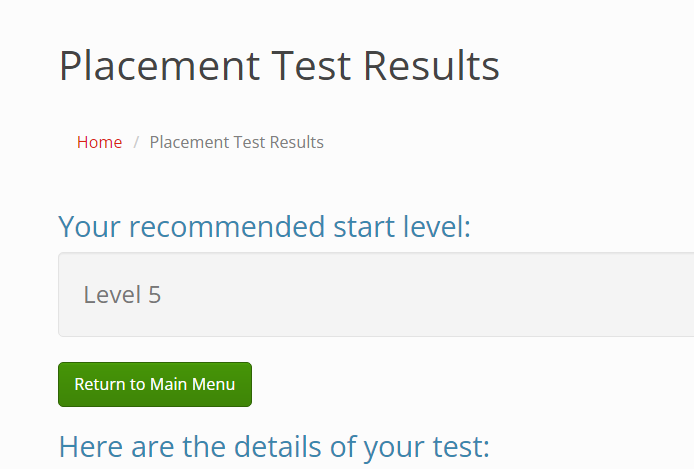
Parents should be aware that each stage has about 5 questions to them and there are around 20 stages in total so it is pretty comprehensive but, because students start at level 1, it can take a while for more advanced spellers to get through.
Sequential Spelling: What’s Required
There are two main components to Sequential Spelling, a Teacher Book (instructor’s manual) and a Student Workbook.
The Teacher Books are probably the most important component to the program, as they contain the 180 or so word lists (4000-4500 words per book), scripted instructions for conducting the first few lessons, background information on spelling rules and English language concepts and notes on things like homophones , heteronyms, prefixes, suffixes and so on.
Alongside the Teacher Book is a Student Workbook, which is where students enter their daily work and have access to and can work on their daily lesson activities.
There is also an optional Student Response Book, which are ike the Student Workbooks but are organized a little differently.
Rather than being sequentially organized, in the Student Response Book the space the student has to write down for each lesson’s word lists is spread out across the book.
This means that, for example, the first week’s lessons won’t be neatly laid out on the first page (lesson 1, lesson 2, lesson 3).
Instead the first day’s lesson space may be on page 5 of the book, the second day’s on page 7, the third day (expanding further) on page 9 and so on.

While a bit quirky, there actually is some solid reasoning behind this.
Because students begin writing on a different page, with adjacent columns having nothing to do with one another, it makes it harder for students to sneak a glance at their previous work and cheat, and prevents students from simply adding prefixes or suffixes to pre-existing words.
They’ll have to put in the effort and actually write things out, reinforcing their learning through writing.
As a result, we actually recommend that parents try out the Student Response book, even if it looks a little odd.
How Sequential Spelling Works
Sequential Spelling doesn’t teach spelling quite like other spelling programs.
The program, originally designed to help dyslexic students, is based on the Orton-Gillingham approach to spelling and reading.
In particular, it teaches spelling:
- Explicitly – students learn what they need clearly and in a straightforward manner
- Sequentially – concepts are approached in a logical sequence
- In a multisensory manner – using the various cognitive pathways and learning styles, such as auditory, visual and kinesthetic.
- With a good deal of review
Phonograms and spelling
Rather than grouping its word lists thematically or around age- or grade-appropriate vocabulary, Sequential Spelling groups its lists of words systematically and phonetically by word families, such as -at, -ain, -uce, medi-, -icit, -end, -ically, and more.
Explicit teaching and Spelling Rules
Unlike many other spelling programs, sequential spelling doesn’t really focus as much on top-down teaching of spelling rules and theory.
Instead, as students go through their word lists and lessons, they are encouraged to develop their own connections between word families, using pattern recognition and inductive reasoning to intuit their own rules and internalizing the spelling of words.
While the manuals do introduce and explain certain spelling and language rules, and do explicitly point out homographs, heteronyms, affixes and more, the overall idea is less about teaching students jargon and concepts than it is about getting them to spell and to become familiar with how words are built and expanded upon by teaching it in as straightforward a manner as possible.
Sequential Learning – building vertically and horizontally
When using Sequential Spelling, students learn word relationships in a logical and sequential manner, learning how root sounds connect to other letters, suffixes and prefixes, to “build” into different and more complex words.
They do this through what they call vertical and horizontal spelling development.
With vertical development, students first see how letters (and sounds) can be added to certain word families to create new words as they work downwards through the wordlist.

Over a period of several days, starting from day 2 of the week, students then work on horizontal development. That is, they examine how different endings can be added on to their words, expanding them, so to speak.

As they attempt to spell these words, and then correct themselves, they observe and discuss their observations, working out and absorbing certain patterns and letter combinations that will help them in their spelling.
Multisensory Lessons
In keeping with an Orton-Gillingham approach to teaching spelling, Sequential Spelling’s lessons are also multisensory, something that is perhaps alluded to through the publisher’s name Audio Visual Kinesthetic Oral publishing (AKVO). .
During a lesson, parents recite the words to the student (auditory), students then write what they hear down as best they can (kinesthetic), parents write down the correct spelling, highlighting and distinguishing key sounds for their student in different colors (Visual) before students review the proper spelling and try again (visual, kinesthetic).
Review
At the end of each lesson, students are offered a daily activity to reinforce their learning from the world lists and to emphasize the meaning of the words.
These differ, depending on the day and lesson, but can involve things like word jumbles, word searches, definition work and more, that provide repetition and reinforcement.

In keeping with Orton-Gillngham best practices, Sequential spelling also periodically reviews previously learned material through the use of optional “tests” (really reviews of previous word lists) that are given every 40 days.
What are Lessons Like in Sequential Spelling
Depending on level, books in the Sequential Spelling series contain about 168-180 lessons that cover between 400-4500 words each.
Lessons begin with a dictation exercise conducted by parents based on that day’s word list- parents recite a word, using it in a sentence, and students write it down, doing their best to spell it correctly.
Once this is complete, parents then write the word down correctly, ideally on a whiteboard and using multiple colors (such as red and black) to distinguish the word families and key sounds from the rest of the word.
If needed, students then erase and correct their own work before both parent and student move on to the next word.
And, with Sequential Spelling, this self-correction is really the key part of the lessons.
It gets kids thinking about spelling, sounds and word relationships, and lets them (over time and perhaps with the help of a parent) begin to identify patterns between the words they’re hearing, what they’re writing down and how words are spelled, all of which help develop a stronger and more intuitive understanding of spelling.
Each lesson contains around 25 words to go through, and the whole process should take around 20-30 minutes or so, depending on the skill and ability of the student, so lessons aren’t too time consuming.
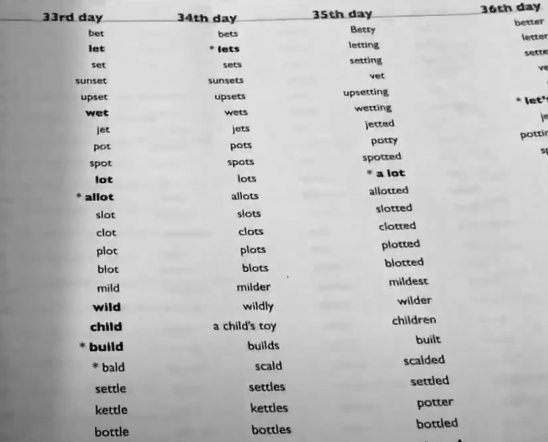
After students and parents work complete their word lists, there is a daily activity to reinforce the learning. These vary, but (as mentioned previously) can be in the form of word jumbles, word searches, sentence construction and more.
Overall, Sequential Spelling, while perhaps a little different than other programs, provides a fairly thorough and comprehensive learning experience in our opinion.
As they go through the lessons, they are made aware and take note of essential concepts such as homophones, homonyms, heteronyms, affixes and get solid explanations about word families and their relationships.
And they do so in a systematic manner.
Rather than studying lists of random words, over the course of several lessons, students learn the phonographic relationships between words, how words are constructed and built out of sounds and learn, over time, to identify these patterns in order to more intuitively spell later on.
In addition, while parents and students work together through lessons, there is a stronger emphasis on independent learning with sequential spelling.
With this program, students are encouraged to self-edit, to examine their own work critically and improve, rather than relying on parents to correct their spelling at the end of each lesson.
This also means that feedback is immediate and relevant – students correct their mistakes one by one after making them, rather than receiving several corrections twenty minutes later, which tends to be more effective in the learning process and in retention.
We also like that there is a lot of review baked into the program, each lesson contains a review component, where students review and make use of their word list, and there are comprehensive, periodic reviews every 40 lessons or so.
Similarly, students also get a lot of practice on their writing skills when using this program.
Not only do students have to write out up to 25 words per lesson, but from time to time will have the opportunity to engage in writing heavy activities, such as writing out dictated sentences or creating their own, so it can reinforce any writing practice that a student is receiving.
Finally, the program is quite flexible. Beyond the essential core dictation and word lists, parents are free to add or subtract material to or from the program without worry of creating any conflict.
On the downside, while they are included in the teacher manual, spelling rules aren’t taught quite as explicitly or formally in lessons as in other programs, relying on students to come to their own practical understanding over time through inductive reasoning and pattern recognition.
While this may be great for kids who like to explore or figure things out on their own, it may not be ideal for students who require a little bit more framework, are memorization-oriented or who have a burning need to understand the why behind English language rules.
Also there can be a fairly rapid change in word families throughout a lesson, such as going from -up to -ood to -out, which can confuse students when they first start out.
How Intensive is Sequential Spelling on Parents Time
Sequential Spelling is not traditionally a self-study program.
Although lessons aren’t particularly long (they can be completed in 20 minutes or so), they do require parents to be engaged and actively participating in the lessons, dictating word lists, writing out correct spelling and discussing emerging patterns and observations with their students as they work these out.
That said, it is fairly straightforward and the teacher’s guides are actually quite well scripted.
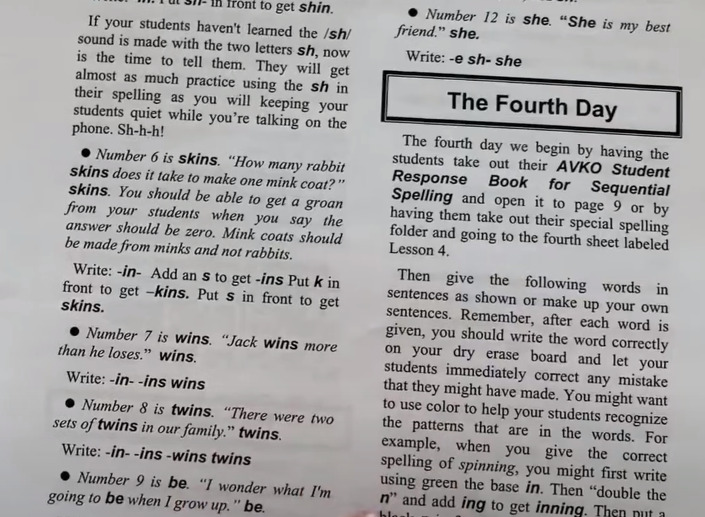
The first few lessons rather explicitly tell parents how to teach concepts in a very step by step manner, after which parents can more or less take over without much of a problem.
The teachers manual also provides fairly detailed notes of spelling and ELA topics, including explanations of spelling concepts, that parents can use to fill in their own gaps in knowledge or weave into the instruction should they feel it is beneficial, which adds to the programs overall flexibility in our opinion.
As a result, Sequential Spelling is fairly easy to use and can be a good resource for those beginning to homeschool or for parents who aren’t as certain about their own English language and spelling skills.
Sequential Spelling Online
In addition to the traditional, pen and paper book series, Sequential Spelling is also available as an online learning program, which turns the program into more of a self-study program, which can be very beneficial to busy homeschooling parents who may not have the half hour a day to be able to devote to spelling.
Like other online learning programs, Sequential Spelling Online essentially takes the place of the parent in the lesson, reading words aloud to students, who then type the word into a box.

If they get it right, the program offers praise and moves on.
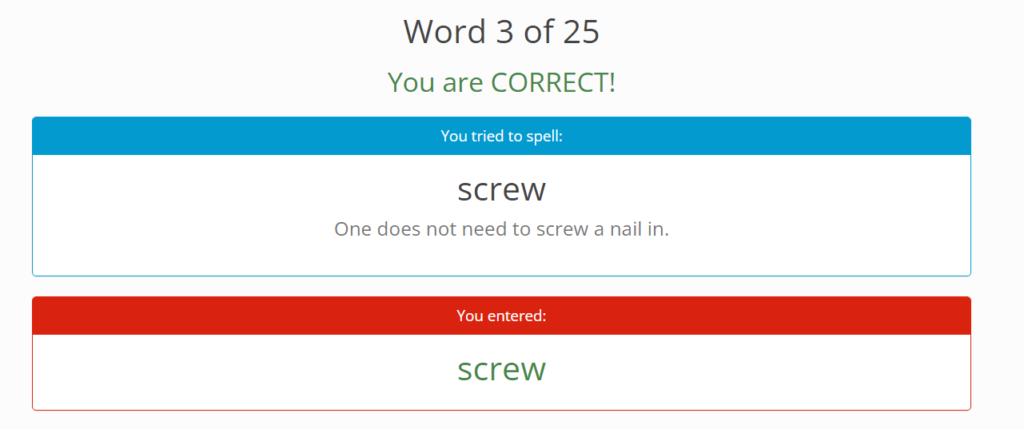
If they get the word wrong, much like the parent is supposed to, the program offers the correct spelling (with the word family sound highlighted) and allows the student to see how their work contrasts with the proper spelling.
Much like the book series, following the lesson, a daily activity is offered in PDF form, which students can print out and work on independently.
Student responses and lessons are tracked in this program, which is helpful and parents have access to essential progress tracking, which allows them to keep track of student progress and performance (as well as if the student is actually doing their lessons altogether).

And parents can dive into each lesson to get a more fine grained picture of their student’s performance on each question.
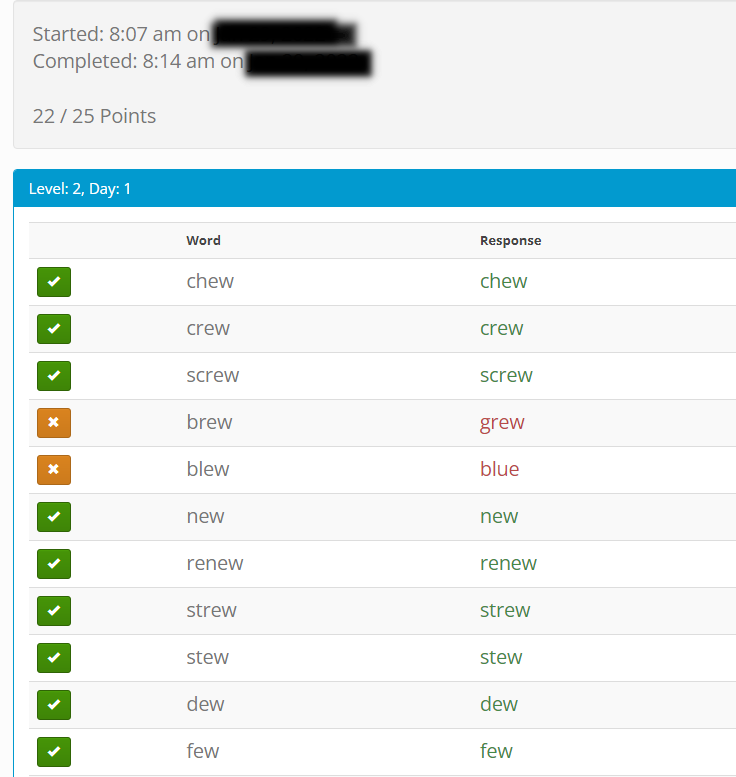
In addition, once an account is created (and before learning material is assigned to a student), parents can take advantage of a fairly thorough and automated placement test, which can give them a better idea at which level their student should start.
The online option doesn’t have as much handwriting involvement in each lesson and does require stronger keyboard and mouse skills on the part of students, however it does do a good job at replicating the essentials of book program and can be a real time saver for parents and a preferred option for students who prefer to learn independently.
Overall, however, we found the online Sequential Spelling program to be simple to navigate and pretty straightforward, working smoothly and effectively.
One issue we did find with the program was that the lesson’s narrator does speak a little quickly at times, particularly when it comes to using words in a sentence. Given that the lessons can have a lot of homophones and similar sounding words in them, students may need to pay a little closer attention.
Sequential Spelling Pros and Cons
Pros
Multisensory approach
Sequential Spelling is a multisensory spelling program, with lessons that integrate auditory, visual and kinesthetic aspects in the form of dictation, demonstration, writing, observation and correction.
This not only makes lessons more interesting, but activates different cognitive learning pathways, thereby strengthening learning and making lessons more engaging.
Fairly sophisticated and enriched spelling lists
Although it starts off with relatively easy words, Sequential Spelling doesn’t shy away from introducing students to more challenging and rigorous vocabulary, making even lower levels enriching for younger students and more appropriate and usable for older students looking to brush up on their spelling.
Sequential and logical approach to spelling and word lists
Rather than relying on grade-leveled or thematic word lists filled with random words, Sequential Spelling approaches spelling using a structured and logical approach based on word families that teaches students how words can be grouped by key sounds and expanded upon with different letters and endings.
Well scripted, easy to use
Sequential Spelling offers parents a good degree of scripting in the first few lessons of each book, clearly outlining its process, offering guidance, hints and tips, and generally guiding parents through lessons in a step by step process until they get the hang of it.
Very to the point
There isn’t a lot of jargon, extraneous text, artistic flourish or busywork in Sequential Spelling.
Lessons get to the spelling and learning component quickly and efficiently.
Continuous review
Sequential Spelling has a lot of review and revision baked into its program. Each lesson ends with one of a variety of activities designed to review its word list, and there are periodic word list reviews/tests of previously learned material every month or so.
Frequent repetition and review of information is a proven method to help students shift information into long term memory and help with recall later on, allowing students to spell quickly and more accurately in the long term.
Online, self-study option available
Although the book form of Sequential Spelling does require relatively intensive parental involvement, it is also available as an automated, online self-study program that replicates its lessons pretty well and can free busy parents up a bit more.
Encourages self-editing and independent learning
A key component of Sequential Spelling is that it requires students to examine their own work and compare it to the correct spelling. This not only helps students observe patterns and develop their own understanding of spelling rules and relationships, but also encourages good self-editing and independent learning skills that can better serve them in the future.
Lessons are short and not all that stressful
Sequential Spelling lessons typically take about 20-30 minutes to complete, depending on the student. With a minimum of busy work and quizzes to complete, they are relatively short and not particularly stressful to go through.
Good amount of handwriting practice with book curriculum
The pen and paper version of Sequential Spelling requires students to write words out and has a variety of activities that will get them writing sentences out by hand, allowing them to practice their handwriting skills as they work on their spelling.
Flexible
Sequential Spelling lessons are pretty open and straightforward as far as spelling programs go. Beyond the core dictation and correction component, there isn’t really a lot stopping parents from adding additional practice into the program and putting their own spin on things.
Cons
Not a huge emphasis on spelling rules and facts
While the teacher’s guides do provide a good amount of Sequential Spelling aims to help students develop their own connection and rules about how words are related and built.
As a result, there’s not as much formal instruction on spelling rules and facts with Sequential Spelling compared to some other spelling programs.
Online version does speak a bit quickly at times
The online version of Sequential Spelling turns the program into more of a self-study program partially by having a narrator take the place of the parent when reading word lists aloud. Unfortunately, the narrator can speak quickly at times, especially when it comes to using the target words in sentences.
Can be challenging to switch into at higher levels
A little more rigorous than other spelling programs, Sequential Spelling’s levels don’t necessarily correlate to grade levels. As a result, parents need to look at their child’s skill level and work through some exercises or the placement test to figure out where they should start, even being prepared to initially start at a lower level and move up.
Who Is Sequential Spelling Ideal For?
Multisensory Learners
Sequential Spelling lessons involve listening, writing, reading/seeing, processing and rewriting. As a result, they are multisensory, can deepen learning and can be of great help to students with different learning styles.
Students that hate memorizing rules and facts
Sequential Spelling allows students to explore and ultimately intuit their own connections and rules concerning words and spelling.
While the teachers’ guides offer some background in spelling rules and language concepts, there is more of an emphasis on pattern recognition and word relationships than there is memorizing and applying facts and rules.
Students that need consistent review, drill and practice
Some students benefit from more immediate and frequent drill and practice of their spelling, and with each lesson ending in a word list review (and periodic, comprehensive quizzes), Sequential Spelling can provide it for them.
Older students who need remediation with spelling
Sequential Spelling is organized by progressive levels, rather than grade, and its sophistication and rigor allows older students to use and benefit from even its lowest levels without feeling condescended to.
Students looking for a spelling program that can offer an enriched vocabulary
Sequential Spelling starts off very approachable and gently introduces more sophisticated vocabulary to students, allowing students to work on more challenging words that are beyond what most programs offer for similar grade levels and ages.
Parents looking for a straightforward, easy to implement program
Sequential Spelling keeps its lessons fairly straightforward and easy to understand, with a minimum of busy work or extraneous activities. They are also pretty open and go for even inexperienced homeschoolers, due to the ample scripting provided in the teacher’s guides.
Parents looking for a structured and logical approach to spelling
Sequential Spelling approaches spelling with a logical and structured methodology. This is not a program with random word lists, but rather organizes its lists by word families and tries to help students understand spelling patterns, how words can relate to each other and how they can be constructed using different beginnings and endings.
Who Is Sequential Spelling Not Ideal For?
Students who hate drill and quizzing
Some students hate quizzes and drill, and since every lesson in Sequential Spelling begins with a sort of dictation exercise or spelling quiz (and ends with review exercises), they may not enjoy their learning quite as much.
Students who enjoy hands-on learning
Although it is multisensory, there isn’t much in the way of hands-on learning with this program. Lessons mainly involve listening, reading and writing and there isn’t much in the way of spelling manipulative use, such as by using letter tiles.
Parents and students looking to learn spelling rules and facts
Formal instruction of spelling rules and facts aren’t really the main focus of Sequential Spelling and don’t play as prominent a role in the program as they do in some others.
Price
Note: Prices correct as of writing. All prices in USD.
As with other spelling programs, there are a couple components parents are expected to buy with Sequential Spelling – a teacher’s guide, called the Teacher Book, which contains the word lists and teaching instructions, and a student workbook, which contains space for responses and a variety of daily activities.
There is also an optional student response book, which provides space for the student to enter their word lists and spreads each lesson across various pages, so students can’t just copy from the previous day’s lesson.
For each level, each book costs:
Student Workbooks:$15.95
Teacher Book: $19.95
Bundle Student Workbook and Teacher Book – $35.90
Student Response Book: $15.95
In terms of the online program, things work a little differently. Parents and students can sign up for an account for free, but purchase access to each level by buying a credit.
Each credit provides access to one level for one student, and costs $19.95.
Parents can save a little by buying in bulk, with 5 credits (5 students/levels) for $79.95 or 10 credits (10 levels/students) for $99.95, which can be an interesting option for larger families or microschools.
Overall, in terms of price, Sequential Spelling is one of the more affordable spelling programs out there.
A complete year’s package costs less than $40 making it less expensive than some other homeschool spelling programs, such as Spelling You See and All About Spelling.
Similarly, the online program is quite affordable as well, providing access to automated course material and progress tracking for less than $20 per student per year, significantly less than most other educational online platforms.
As always, however, parents should check for current pricing, as well as for any deals or specials that might be offered.
Is It Worth the Price
Sequential Spelling is not only an affordable program, it also provides a lot of value for money.
The program offers a unique, Orton-Gillingham inspired, organized approach to spelling that teaches students word families and their relationships while helping them intuit and internalize their own understanding of spelling rules and patterns.
The word lists are logically connected and laid out and consist of quite a few challenging word list entries, which can challenge and enrich a student’s vocabulary to a degree beyond that of most other spelling programs out there.
It is also a program that is quite simple, short and easy for parents to implement, with lessons that are consistent and free of extraneous jargon and busywork.
Finally, Sequential Spelling also offers a fairly well-designed and affordable online program that turns the curriculum into more of a self-study program that can be an effective timesaver for busy homeschools.
Bottom Line
Spelling isn’t always the easiest subject for homeschoolers and can often be frustrating for both parent and student.
With its logically laid out approach, consistent and short lessons and enriched word lists, Sequential Spelling can help students learn to spell quickly, accurately without a lot of frustrating rote memorization.

About the Author
Anne Miller is the editor of The Smarter Learning Guide and is a passionate advocate for education and educational technology. A mom of two, she majored in English Language and Literature and worked as a substitute teacher and tutor for several years. When not writing she continues to root for the Yankees and the Giants.
